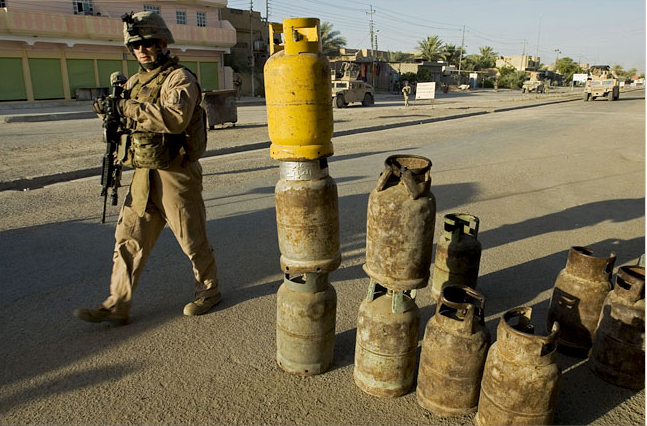Much is made of how the mainstream media, and especially the “paper of record” underwrites a status quo mentality that often seems to play into, if not outright endorse, administration politics. There are good reasons for this, to be sure, and we have done our fair share here at No Caption Needed and over at The Bag of criticizing the ways in which photojournalism too often contributes to the normalization of such politics. What we must not forget, however, is that photojournalism is a complex and often eloquent public art, a technology of ingenium that functions in a wide range of ways to display and animate public life.
Earlier this week the NYT published a photograph that demonstrates how photojournalistic efforts can begin to frame a critical civic attitude, even as it adheres to the conventions of realist representation that might otherwise support a status quo sensibility and the current administration’s point of view. On 8/19/07 the NYT posted a picture of a single marine walking down a street in Falluja as part of a story concerning the “fragile calm” that has descended upon the city as a result of U.S. military presence there.
The street seems to be a main public thoroughfare, but there is no evidence of a public. Besides the lone marine in the foreground and what appears to be another marine in the distant background, almost too small to see, there are no other people and quite clearly no Iraqis. The only vehicles bear military camouflage, certainly no small consideration given the significance of car bombs, but also a reminder of the citywide vehicle ban imposed by the mayor and enforced by the U.S. military presence. Interestingly, however, it is not the marine who captures our immediate attention. Rather, it is the rusted and dirty propane tanks that literally divide and dominate the scene. Stacked high and teetering, like a house of cards, they seem somewhat out of place. The top yellow tank is especially strange, drawing our attention to the midline of the image and underscoring that this is where the narrative action of the scene resides. The caption makes the point, “Many wonder what will happen when they [the marines] leave,” while the image seems to imply that it is the very presence of the U.S. military that guards and helps to sustain the peace.
But a second look at the photograph invites a more critical attitude. The marine walks cautiously but with his rifle pointed down in a manner that suggests that he does not think he is in eminent danger, evidence of at least a modicum of peace and calm, though the situation can’t be all that safe or he wouldn’t be carrying his rifle in front of him (or, for that matter, he wouldn’t be wearing body armor). Indeed, his somewhat tentative posture implies a calm “before the storm” rather than the “peaceful” and self-sustaining calm we might associate with something like, say, meditation. The photograph thus invites a certain cynicism about the very premise of a fragile calm, which here seems to be more feigned than real—indeed, the empty streets are somewhat eerie, more evocative of a ghost town than a city in which peace reigns. Additionally, notice that the marine, the sign of American power, walks in a shadow, partially veiled by the darkness, an ominous sign of death and otherness. By contrast, the propane tanks, containers for fuel and thus the necessary power to make the city work, stand prominently in the light of day. As tall as the marine (and by implication as potentially powerful as he, though presumably empty), they are also clearly unstable. They command the viewer’s attention, although apparently not that of the marine, as he seems oblivious of either their presence or their precarious posture.
There are, I believe, two different ways to read this last dimension of the photograph: Either the marine simply doesn’t see the problem, ignorant of the true instability of local power and politics, or he chooses not to see it because he believes that there is nothing – absolutely nothing – he can do to prop up local power in the long run. Understood in this way, the photograph is an elegant and eloquent metaphor for the situation in Iraq, showing what might otherwise be hard to say: ignorance or resignation, it really doesn’t matter because, in the end, the task is very much like sustaining a house of cards, fated to failure. The photograph thus coaches a critique of the very premise of a “fragile calm” that informs the accompanying article – and by implication the administration’s subsequent appeal for continued patience and support – as anything other than hubris bolstered by dictatorial control.
Photo Credit: Marko Georgiev/New York Times

Discussion